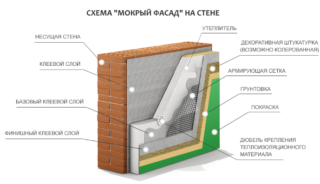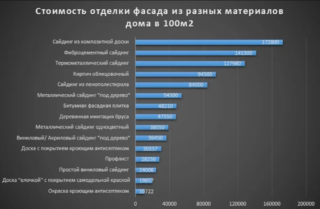Before restoring the surface of the outer walls, an inspection is carried out to determine the degree of destruction of the finish. The norms provide for redecorating the facade in 5 years, and major restoration is done every 10 years. The works refresh the appearance, restore the attractiveness of the building. Before the start of the major restoration, engineers and designers work; finishers, sculptors, and artists are involved in the work on site.
Varieties of repair work
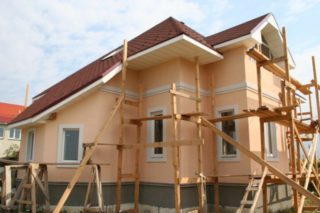
The facade performs an aesthetic function, while protecting the building from negative factors. Cracking of the finishing layer causes the inner layers to become wet, reducing the thermal protection.
The restoration includes a complex of repair processes:
- inspection of walls, architectural structures, decorative elements;
- restoration and restoration of walls;
- reconstruction of the lost parts of stucco molding, ornaments;
- cleaning walls from layers;
- replacement of thermal insulation, hydro and vapor barrier.
The scope of work depends on the degree of deterioration and the type of finish. Repair of a ventilated frame and plaster is complex and different stages of implementation.
Emergency
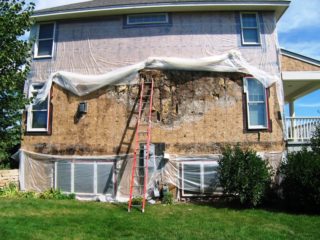
Repairs are carried out urgently and unscheduled. The aim is to restore the protective functions of the facade walls. The reason for the violation of integrity lies in the sudden destruction of the bearing elements, for example, under the action of the elements. Destruction can be dynamic and build up in a short time.
In case of emergency repairs, recovery begins immediately. The amount of work depends on the degree of damage, it can be partial or include the replacement of finishing throughout the entire area.
Whether or not to stick to the original look depends on the wishes of the owner. Emergency repairs are often combined with the transformation of the facade and the choice of a different style of cladding.
Capital
A thorough restoration is planned well in advance; repairs are expensive. Recovery begins when external damage occupies more than 30% of the area of the walls. Sometimes repairs are made due to a change in the functionality of the structure, as a result of which a change of image is required.
The main scope of work:
- removal of the previous finish;
- restoration of the surface structure;
- sealing joints and installing waterproofing;
- repair or replacement of insulation;
- execution of a new cladding;
- repair or installation of a drainage system.
Cleaning the walls from debris and old layers is important. For this, karchers are used with a high jet pressure.
Cosmetic
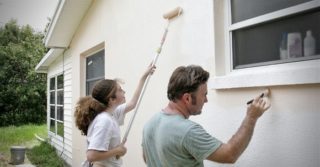
Such repairs are done regularly to delay the overhaul. Partial restoration includes spot restoration of individual surface areas up to 0.3 m².
Types of work for different finishes:
- decorative plaster or putty is applied in a layer at the place of damage, primed, painted;
- change the cracked tile to a similar one from the stock;
- remove and install a new strip of plastic, siding instead of the old broken one.
Redecoration of the facade of the house returns its visual appeal with little effort, so they are carried out regularly.
Reconstruction
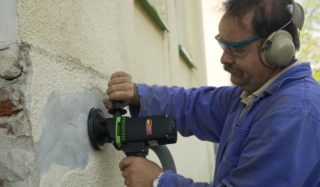
The work involves a complete change of the finishing and protective layer as a result of the reconstruction of the elements of the facade or the structure of the entrance. In the process, stucco moldings are removed from the facade, bay windows, skylights, can change the shape of the openings.
Reconstruction involves replacing:
- windows, door fillings, window sills;
- ebb, interfloor and basement cornices;
- canopies, awnings, stairs.
During the reconstruction, architectural structures are removed and changed, terraces and verandas are added. In the process, they examine balconies, observation decks and repair them.
Finishing materials
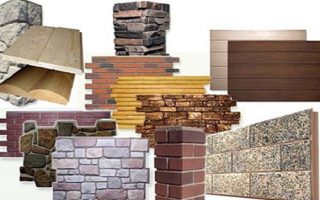
Each material used in the restoration of the facade has special qualities, therefore, private houses, commercial buildings are finished taking into account the properties and characteristics. With simple repairs, the type of cladding does not change, and restoration and overhaul involves changing the decorative layer.
Apply types of finishes:
- simple and decorative plaster;
- vinyl and metal siding;
- facing front brick;
- fake diamond.
For each option, its own technology follows, while the repair measures repeat the process of the initial application in combination with preparation.
Plaster
Take into account the compatibility of the old and new layers in terms of chemical composition, so that bubbles or flaking do not appear. The old layer is left if it adheres firmly to the wall. Moving layers differ in sound when tapped, such areas are removed and a new finish is made.
Siding
The panels are durable, but over time they can burn out or bend from impacts. Sometimes plastic siding has cracks and through holes. If the impact is strong, there is a deflection of the frame elements.
Inspect the place of destruction and make a decision on the repair. Most often, only the strip is changed, but sometimes it is necessary to redo the racks of the crate. Often, to replace the panel, it is necessary to disassemble the coating from the end to the damaged area, since the elements are recruited sequentially, it will not be possible to remove the strip from the middle. For replacement, take a material that is suitable in color so that it does not stand out against the general background.
Facing brick

The brick layer is placed on the surface because of its strength and attractive appearance. It is not difficult to restore such a finish, but knowledge of the specifics and adherence to technology is required.
The brick is in the finish for a long time, but over time, the surface collapses, the solution in the joints, or a bloom of moss and vegetation appears.
Small cracks in the brick are sealed with cement mortar, the chipped elements must be replaced. In this case, the old stones are dismantled with a chisel, hammer, crowbar to the extent that they make room for new brick. Moss is removed with brushes, a spatula, the surface is primed for hardening.
Fake diamond
Piece elements are placed strictly in a geometric order or installed randomly. Surface repairs are done with this in mind. Dismantle rectangular tiles that have collapsed or cracked, remove the remnants of mortar or glue. A chisel or perforator is used, sometimes a bump stop is needed - it all depends on the size of the tiles and the adhesive.
The surface is primed, a new element or group of tiles is set on glue. Rub the seams between the stones. For randomly located tiles, for example, sandstone, the technology is similar, but it is more difficult to select a stone of the required shape. Sometimes the elements are cut to the desired configuration with a grinder.
What tasks does facade repair solve?
A set of measures improves the external perception of the building. Attractiveness depends on the little things, each element should be integral and complement the overall picture of the exterior.
Small cracks, collapsed plaster, broken plastic panels, fallen bricks, tiles must be put in place and repaired to make the building look neat and well-groomed.
Calculation of the amount of material
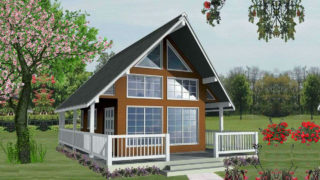
The amount of materials depends on the type of repair and its scale. Special formulas can only be applied to completely replace the finishing layer. In this case, the area of the material is considered by the quadrature of the entire facade, a factor of 1.1 or 1.15 is added for cutting to size, if the specifics of the installation require it. Wet solutions are counted by weight and in kilograms.
To find out how much plaster is needed, take the area of the repaired area and multiply by the average layer thickness, for example, 15 m² x 0.02 m. You get 0.3 m³ of mortar. Kilograms can be calculated by multiplying the weight of the mortar, which is required for plastering 1 m² with a thickness of 1 mm (written on the package) by the average thickness of the repair layer, then by the total square. For example, 1.1 kg (consumption) · 2 mm · 15. Get 33 kg.
Preparatory work
Diagnostics of the facade surface is carried out and the quadrature of the areas for repair is determined. After that, they beat off the weak cladding or remove the siding panels, plastic from the frame. The surface is cleaned with a Karcher under pressure (for wet finishing) in order to knock out grains of sand and loose inclusions from the area.
It is mandatory to prime the surface with deep penetration compounds. Sometimes an impregnation is required to prevent the formation of microorganisms, inflammation or decay. After all layers have dried, you can proceed with the restoration of the facade.
Stages of repairing the facade with your own hands
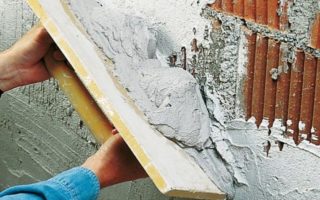
In a private house, the timing of the repair is determined by the owner so that his home always has a beautiful view. For example, you can refurbish tiles, plaster or curtain walls after winter is over.
Work order:
- purchase of the required amount of materials;
- preparation of the necessary tool;
- removing the old coating;
- surface preparation for repair;
- repair of insulation, insulation membranes;
- installation of areas of wet plaster or piece elements;
- primer if necessary;
- coloring.
Regular small repairs postpone large and large repairs. Major repairs are costly, it is better to constantly make minor updates to individual areas.
The cost of repair work
You can restore damaged areas on your own, but specialists will make the repair better. Work on cosmetic surface refreshing without reconstruction of the supporting elements of the frame costs 300 rubles / m², and restoration of the insulation layer with the reconstruction of the hinged frame will cost about 600 rubles / m².
Approximate cost of individual procedures:
- primer - 30 rubles / m²;
- restoration of lathing elements - 500 rubles / m²;
- removal of efflorescence, moss, hydrophobization - 200 rubles / m²;
- deep repair of plaster - from 650 rubles / m²;
- surface cleaning - from 40 rubles / m²;
- plaster - 350 rubles / m²;
- painting in one layer - 60 rubles / m²;
- repair of masonry - from 600 rubles / m²;
- cleaning and grouting - 100 rubles / m².
To reduce the amount of payment for the work of specialists, you can do the preparatory activities with your own hands, and give high-tech repairs to the masters.

